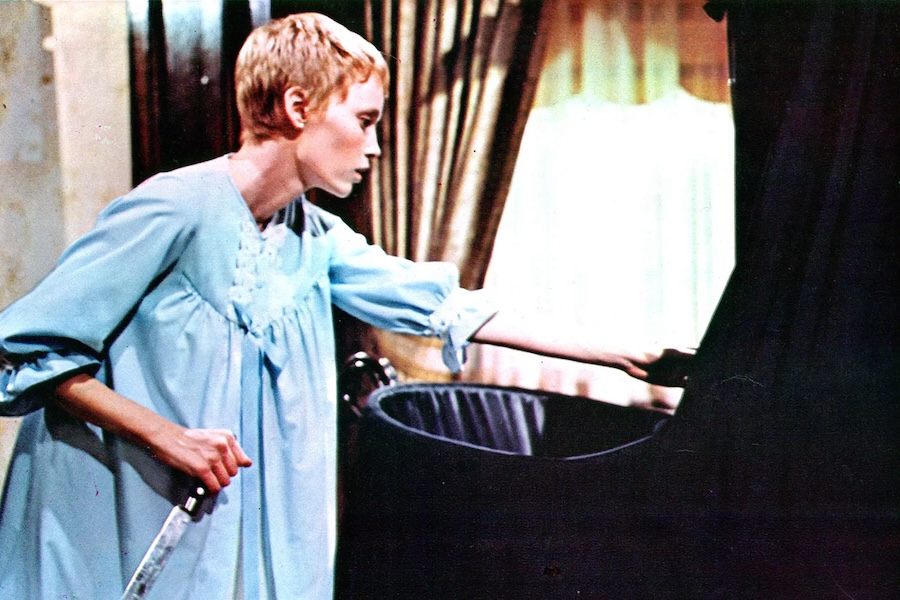
PRAY FOR ROSEMARY’S BABY.

After making Repulsion, Cul-De-Sac and The Fearless Vampire Killers in England, three very good films that differed a lot in style but all had elements of horror in common, Roman Polanski married Sharon Tate whom he had met on the set of the last film and moved to the United States. There he was offered Rosemary’s Baby, a story whose filmmaking rights had been secured by B-movie auteur William Castle who stayed on as producer but was denied the chance to direct the film. After several efforts that flirted with horror, Polanski finally went all in.
A dream that doesn’t seem like a dream
Rosemary and Guy Woodhouse (Mia Farrow, John Cassavetes) move into the Bramford, an old New York building. Soon, they befriend their elderly neighbors, Minnie and Roman Castevet (Ruth Gordon, Sidney Blackmer), who become like a spare set of parents to them, even though Rosemary finds them a bit too intrusive. After eating a chocolate mousse that Minnie made one night, Rosemary passes out and has a weird dream that doesn’t seem like a dream at all, where a diabolical figure rapes her.
The morning after she finds scratches on her body and Guy says that, since this was a good moment to conceive, he had sex with her in spite of her condition. Shortly after, Rosemary learns that she’s pregnant…
A perfect fit for Polanski
A very absurd horror story that became a huge success (both as a novel and a movie), and it’s a perfect fit for Polanski who brings a dark sense of humor to it all the way to the final sequence when the full extent of Rosemary’s nightmare is revealed. It’s possible to view her ordeal as a comedy, because the manipulation of her sometimes becomes too obvious. But at the same time Farrow’s performance as the naive housewife is downright touching; all she wants is her marriage to be successful, and a baby. There is a lot of honesty in that and it isn’t an easy role to play without having it turn into a caricature. Perhaps some of the personal demons from finding out during the shoot that her husband Frank Sinatra wanted a divorce bolstered her strong effort near the end of the film when Rosemary catches on to what’s going on in the Bramford.
There is often very little music, just clocks ticking and dialogue, but in the beginning Krzysztof Komeda contributes a very effective, eerily childish theme.
Polanski and his cinematographer William Fraker cleverly build the eerie atmosphere in those old apartments by shooting the actors from a distance, capturing much of the environment and its solid furniture, leading right up to that creepy black baby carriage. There is often very little music, just clocks ticking and dialogue, but in the beginning Krzysztof Komeda contributes a very effective, eerily childish theme.
Cassavetes is good as the struggling actor who married Rosemary and makes sure that she stays in line. Gordon, who is absolutely delicious as the laidback yet intense neighbor who keeps bringing Rosemary potions, cakes and good luck charms, is a standout. Listening in on a phone conversation that Rosemary has with a colleague of Guy’s is a treat, because that voice ought to be familiar to most people.
The horror aspects of this film has since been far superseded by the likes of other demonic treats such as The Exorcist (1973) and The Omen (1976). Still, the Dakota building is there on the Upper West Side of Manhattan as an ominous (yet affluent) reminder of how it was used as the Bramford in this film… and also the site of John Lennon’s murder. Sometimes, real life horrors are worse than anything Satan does on the silver screen. But Farrow and Polanski’s artistic skills and sense of humor are what make Rosemary’s Baby special.
Rosemary’s Baby 1968-U.S. 136 min. Color. Produced by William Castle. Written and directed by Roman Polanski. Novel: Ira Levin. Cinematography: William A. Fraker. Music: Krzysztof Komeda. Cast: Mia Farrow (Rosemary Woodhouse), John Cassavetes (Guy Woodhouse), Ruth Gordon (Minnie Castevet), Sidney Blackmer (Roman Castevet), Maurice Evans, Ralph Bellamy… Charles Grodin. Voice of Tony Curtis.
Trivia: Alfred Hitchcock was reportedly offered the film. Tuesday Weld, Goldie Hawn and Jane Fonda were considered for the lead role; Robert Redford and Jack Nicholson as Guy. Followed by a TV movie, Look What’s Happened to Rosemary’s Baby (1976), and remade as a miniseries, Rosemary’s Baby (2014).
Oscar: Best Supporting Actress (Gordon). Golden Globe: Best Supporting Actress (Gordon).
Last word: “I had only seen [Farrow] on the cover of Life. To be honest, I was not enthusiastic about her until we started to work. Then I discovered, somewhat to my surprise, that she is a brilliant actress. This is one of the most difficult woman’s parts I can imagine.” (Polanski, RogerEbert.com)
